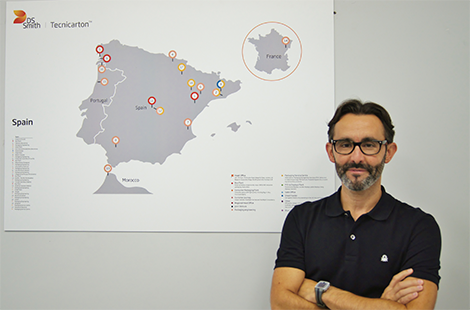Interview with Jorge García, Quality and Management System Manager of DS Smith Tecnicarton
Jorge García: "It is necessary to have effective control systems to detect possible risks that may pose a danger to health"
Jorge García directs the Quality and Management System area of the 10 plants that make up the DS Smith Tecnicarton division.

- What is your work at Tecnicarton and what responsibility does it entail?
My responsibility is to coordinate the management system, within which the Quality department is located, and to offer support so that they can develop it in a homogeneous way.
We have a single and integrated management system for all plants. through which, we get to have an interrelation between all the plants and a similar way of working. The objective is to ensure that any employee knows the work methodology at any stage of the value chain.
- What is the importance of the Quality Department within DS Smith Tecnicarton?
As I have already mentioned, the Quality Department is only one part of the DS Smith Tecnicarton management system. It is necessary to establish a system of action so that the information flows and the interaction between the different processes of the company work effectively. This could be the main and most important function of this department. For this, it is necessary to develop many other subtasks, control actions, monitoring, analysis, etc. always looking for continuous improvement.
- What does it mean for Tecnicarton to have a quality system in place?
The advantages of having a quality management system in place are many, but we could basically summarize them in three: increased efficiency and reduced non-quality costs (increased profitability), improved customer satisfaction and boosting worker motivation
- Are quality certifications a guarantee for clients?
In principle, this should be the case, but the quality management system needs to be effective in order to transmit that security in the product that customers need.
- Let's talk about the food sector. Industrial packaging for food products and bulk supplies is a very important part of Tecnicarton's business. In this sense, what benefits does it mean to be in possession of certifications that guarantee the quality of the processes?
We all know the great importance of health, hence it is necessary to have very clear protocols of action in order to guarantee safety throughout the food chain. Packaging is one of the components involved in this and, for this reason, it is necessary that it meets all the requirements in terms of food safety and has effective control systems to detect possible risks in time, before they pose a danger to health.
- In the case of Tecnitank, this packaging is certified according to the ISTA 3H standard in transport and storage tests, what added value does it imply from the point of view of quality?
Taking into account that the ISTA organization establishes some of the most important regulations and test protocols related to the transport of goods, the fact that this product has successfully passed the 3H protocol gives us a lot of peace of mind, both for us and our customers. These ISTA test protocols and procedures allow to reproduce the risks that packaging suffers during the transport and distribution of goods and, in this way, to guarantee their safety throughout the distribution cycle.
-What are the closest future challenges facing the quality department?
At this moment we are working on including the Lean methodology and continuous improvement in our own management system. We understand that we have to adapt and incorporate proposals that add value.
On the other hand, we cannot forget that the management system must be flexible but rigorous, and with the capacity to adapt to new legislation and to the demands of customers. The demands of projects, and more in our case that they are personalized projects, require a management system that takes this into account.
